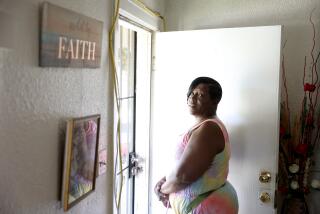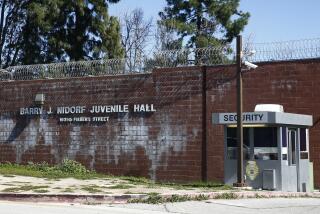Opinion: Is L.A. County’s foster system raising the next generation of homeless people?
Young people whose families can’t raise them fall under the jurisdiction of the county, which arranges for foster care and, ideally, provides enough resources to give them a decent path toward a self-sufficient adulthood.
It’s a hard road, though. On average, kids who have been removed from their families don’t do as well in school and have a much greater likelihood of ending up in the criminal justice system. Years of neglect and emotional abuse can make foster youth easy targets for sex traffickers.
And all too often, foster care becomes a pipeline to homelessness.
In California, where support was once cut off the instant a young person in foster care turned 18, housing and other assistance now continue through age 21. Still, the challenge of helping move young people toward independence is enormous, as illustrated in Times staff writer Nina Agrawal’s recent stories on the nonprofit David and Margaret Youth and Family Services program in La Verne.
David and Margaret is one of a handful of organizations that contract with the Los Angeles Department of Children and Family Services to provide support to juveniles and to transition-age youth, those who are 18 to 21 years old. The new adults, especially, are a demanding population, desperately in need of help after surviving young lives of abuse and neglect, yet no longer children who can be disciplined for failing to abide by rules meant to safeguard them. Many fall victim to sex traffickers. Nationwide studies suggest that up to 90% of juveniles and young adults who were victims of sex trafficking have been in foster care or otherwise involved in child welfare programs.
It requires a special brand of skill and empathy to protect young people shaped by lives of such abuse. The county has long had trouble dealing with the most challenging cases and for years dumped those who could not be placed elsewhere into MacLaren Hall, the notorious El Monte facility where harried staff dished out physical and emotional abuse and were accused of overmedicating youths just to keep them quiet. After closing MacLaren in 2003, the county has sought to protect the most vulnerable and difficult children and young adults through contract agencies like David and Margaret.
But as The Times reported, the county Department of Children and Family Services shut down a David and Margaret housing program for about 50 transition-age youths in November after learning that an apartment building where some of them lived was the subject of a human trafficking investigation — and allegedly the site of a murder.
Either the nonprofit was not up to the task it had taken on or the department was not capable of exerting the necessary oversight. Or both.
If the county is unable to set youths and young adults on a healthy path, it will in essence be raising the next generation of desperately poor and troubled homeless people.
Although there’s no single driver of homelessness, it’s clear that many people living on the street are “graduates” of county programs like foster care that offer too little, or poorly targeted, help.
Earlier this week, county officials presented some interesting data that might predict homelessness, especially among people living in poverty with meager support networks and safety nets. The data point to some obvious remedies — for example, ending the sheriff’s practice of releasing jail inmates in the middle of the night — and some that may be counterintuitive, especially among the clients of the Department of Children and Family Services.
It turns out, for example, that more than half of L.A. County’s homeless families had been referred at one point or another to the child welfare system. That doesn’t necessarily mean abuse or neglect on the part of the parents was substantiated. But it does suggest a link between whatever stress or crisis led to the call or the referral and the ultimate loss of housing.
And when the department does remove a child from a home, the family often loses eligibility for CalWORKS grants (because the grant was tied in part to the child) — and stands a good chance of becoming homeless, leaving the removed child no home to return to.
Meanwhile, L.A. County officials have long known that the chance of homelessness is much higher among young adults who have been through foster care. After years of wrenching self-examination of a system that still leaves too many kids in harm’s way, it is disheartening that the county still has so much room for improvement.
More to Read
A cure for the common opinion
Get thought-provoking perspectives with our weekly newsletter.
You may occasionally receive promotional content from the Los Angeles Times.










